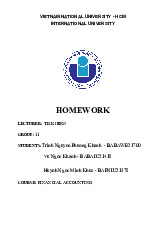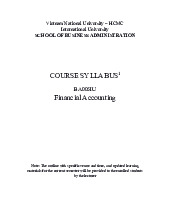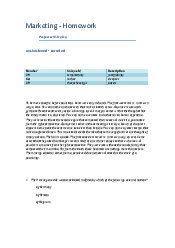







Preview text:
Chapter1: Introduction to Accounting
- Accounting consists of three basic activities: identifies, records,
and communicates the economic events. Who use accounting data?
External: Investors, criditors,…
Internal: Marketing, Finance, Human resources, Managements,… Measurement Principles:
- Historical cost principle (Cost Principle): Dictates that company record assets at their cost.
- Fair Value principle states that assets and liabilities should be
reported at fair value (the price received to sell an asset or settle a liability).
*Form of Business ownership: self-study
** BASIC ACCOUTING EQUATION:
Assets must equal the sum of liabilities and equity
Assets = Liability + Owner’s Equity
Assets: Resources a business owns. Provide future services or benefits.
Assets are form of CASH or MONEY owned by customers and non-monetory
physical things as INVENTORIES, LAND, BUILDING, and EQUIPMENT. Others
assets are nonphysicial such as right granted by patents, trademarks or copy rights.
Liabilities: Present obligations of a business to pay cash, transfer assets, or
provide services to other entities in the future. Ex: supplies of good or
services bought on credit, to banks for loan owned, to employees in form of
salaries and wages, to the government taxes, transfer assets or provide
services to other entities in the future.
Owner’s Equity: represents the claim by the owners to the assets of the
business. It equals the residual interest in the assets of an entity that
remains after deducting liablities
Contributed capital: the amount that is invested in the business by the
stockholders. Represents by shares of capital stock. 2 components:
+ Par value, amount per share that is entered in the corporation’s capital
stock account. Minimun amount that can be reported as contributed capital.
+ Additional paid-in-capital , the amount received for capital stock over its par value.
Retained earning: Equity of the stockholders generated from the income-
producing activities of the business and kept for use later. RE are affected bt 3 kinds of transactions:
1st: Rev and Expenses: Increase and Decrease in Owner’s Equity that result
from operating in the business.
- With Rev: The assets (ex: Account receivable) of the company
increase => OE (RE) increases
- With Exp: all exp make assets decrease and liabilities increase => OE (RE) decrease
- Rev > Exp -> Net income - Exp > Rev -> Net loss
Dividends: Distributions to stockholders of assets generated by past earning (Decrease RE).
RE is accumulated net income less dividends.
Affects of Business Transactions on Financial Position:
Steps in recording a business transaction:
1. What accounts are involved?
2. What are the classifications of the accounts involved?
3. Are the accounts increased or decreased?
4. Is the equation in balance after the transaction has been recorded?
Ex: Purchase of assets by incurring a liability: Purchase office supplies for $1000 on credit
Increased assets by $1000, decrease liabilities (AP) by $1000 => Equation is balance. We have 5 financial statement: 1. Income Statement 2. Retained Earning Statement
3. Statement of Financial position 4. Statement of Cash flow
5. Comprehensive Income Statement
Chapter 2: Analyzing Transactions
T-Account: Record of increases and decreases in a specific asset, liability,
stockholders’ equity, revenue, or expense item. Debit = Left, Credit = Right. It
is used to analyze transactions,
Every transactions affects at least 2 accounts. For each transaction, one or
more accounts must be debited and one or more accounts must be credited.
And total debits must equal total credits.
If the sum of Debit entries are greater than the sum of Credit entries, the
account will have a debit balance.
If the sum of Credit entries are greater than the sum of Debit entries, the
account will have a credit balance Assets Liabilities Debit for Credit for
Debit for decrease (-) Credit for increases (+) increase (+) decreases (-) Owner’s Equity
Debit for decrease (-) Credit for increases (+)
Step in analyzing processing transactions:
1. Analyzing the transaction to determine its effect on assets, liabilities and OE.
2. Apply the rules of double entry. 3. Record the entry.
4. Post the entry in T account.
5. Prepare the trial balance to confirm the balance of the accounts
Assets = Liabitities + Common stock + RE + Revenues – expenses – dividend
Dr: (+) (-) (-) (-) (-) (+) (+)
Cr: (-) (+) (+) (+) (+) (-) (-) Recording process (slides);
1. Determine what type of account is involved
2. Determine what items increased or decreased and by how much.
3. Translate the increases and decreases into debits and credits Trial balance:
1. List T account that has a balance
- Record debit bal. in the left colume
- Record credit bal. in the right colume
- List accounts in the order that they appear in the ledger 2. Add each colume
3. Compare the comlume totals, total debit should equal total credit
Chapter3: Adjusting process:
Fiscal Year = Accounting time period that is one year in length.
Calendar Year = January 1 to December 31.
Accrual-Basis Accounting:
- Transactions recorded in the periods in which the events occur.
- Companies recognize revenues when they perform services
(rather than when they receive cash).
- Expenses are recognized when incurred (rather than when paid). Cash-Basis Accounting:
- Revenues are recorded when cash is received.
- Expenses are recorded when cash is paid.
- Cash-basis accounting is not in accordance with International
Financial Reporting Standards (IFRS)
Types of adjusting entries:
1. Costs have been recorded that must be allocated between two or more accouting periods
2. Expenses have been incurred but are not yet recorded
3. Unearned revenues have been recorded that must be
allocated between 2 or more accounting periods
4. Revenues have been earned but not yet recorded ** Deferal:
- Recognition of an expense already paid (Type1)
Prepaid Expenses. Expenses paid in cash before they are used or consumed.
- Recognition of an revenue received in advance (Type3)
Unearned Revenues. Cash received before services are performed. ** Accurual: - A revenue (Type4)
Accrued Revenues. Revenues for services performed but not yet received in cash or recorded. - An expense (Type2)
Accrued Expenses. Expenses incurred but not yet paid in cash or recorded. -
PREPAID EXPENSES: Payments of expenses that will benefit more than one accounting period.
Cash Payment BEFORE Expense Recorded
Prepayments often occur in regard to: insurance, supplies,
advertising, rent, bulding and equipment
Increase (debit) to an expense account.
Decrease (credit) to an asset account. -
Prepaid rent Jan2, John advertising Co. paid $4000 rent in advance
for Jan and Feb. As each day of the month passes, part of the asset,
prepaid rent, expires and becomes an expense, by Jan31, half of the
prepaid rent has expired and should be treated as an expense. Jan 31,
prepaid rent of $2000 has expired for Jan. Adjust account by
allocating $2000prepaid rent to rent expense
Adjusting entry: Increase (debit) to an expense account
Decrease (credit) to an asset account.
On October 4, Yazici Advertising Inc. paid ₺600 for a one-year fire insurance
policy. Coverage began on October 1. Yazici recorded the payment by increasing
(debiting) Prepaid Insurance. This account shows a balance of ₺600 in the
October 31 trial balance. Insurance of ₺50 (₺600 ÷ 12) expires each month. Insurance Expense 50 Prepaid Insurance 50
** Depreciation – Contra asset account
** Accumulated depreciation – Contra asset account UNEARNED REVENUES
Receipt of cash that is recorded as a liability because the service has not been performed
Cash Receipt BEFORE Revenue Recorded
Unearned revenues often occur in regard to: Rent, Magazine subscriptions,
Airline tickets, Customer deposits
Decrease (debit) to a liability account
Increase (credit) to a revenue account.
Ex: Yazici Advertising Inc. received ₺1,200 on October 2 from R. Knox for
advertising services expected to be completed by December 31. Unearned
Service Revenue shows a balance of ₺1,200 in the October 31 trial balance.
Analysis reveals that the company performed ₺400 of services in October. Oct 31. Service Revenue 400 Unearned Service Revenue 400
Adjusting Entries for Accruals
Accruals are made to record Revenues for services performed but not yet
recorded at the statement date (accrued revenues). OR Expenses incurred
but not yet paid or recorded at the statement date (accrued expenses)
Accured revenue:
Revenues for services performed but not yet received in cash or recorded.
Revenue Recorded BEFORE Cash Receipt
Increases (debits) an asset account and
Increases (credits) a revenue account.
Expenses incurred but not yet paid in cash or recorded
Expense Recorded BEFORE Cash Payment
Increase (debit) an expense account
Increase (credit) a liability account
Accured interest:
Face of note x annual interest rate x time in term of 1 year




